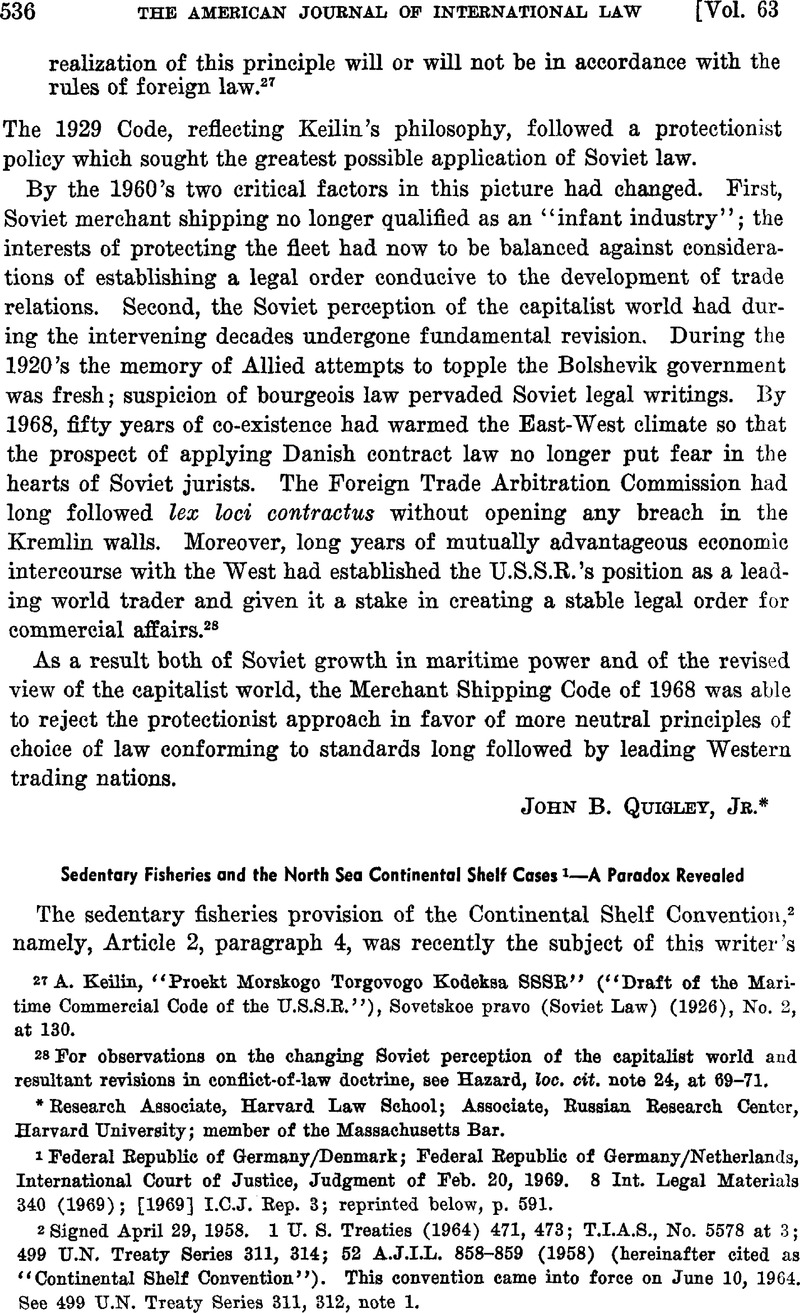Article contents
Sedentary Fisheries and the North Sea Continental Shelf Cases 1–A Paradox Revealed
Published online by Cambridge University Press: 28 March 2017
Abstract

- Type
- Notes and Comments
- Information
- Copyright
- Copyright © The American Society of International Law 1969
Footnotes
Federal Republic of Germany/Denmark; Federal Republic of Germany/Netherlands, International Court of Justice, Judgment of Feb. 20, 1969. 8 Int. Legal Materials 340 (1969); [1969] I.C.J. Rep. 3; reprinted below, p. 591.
References
2 Signed April 29, 1958. 1 TJ. S. Treaties (1964) 471, 473; T.I.A.S., No. 5578 at 3; 499 TJ.N. Treaty Series 311, 314; 52 A.J.I.L. 858-859 (1958) (hereinafter cited as “Continental Shelf Convention“). This convention came into force on June 10, 1964. See 499 TJ.N. Treaty Series 311, 312, note 1.
3 See Goldie, “Sedentary Fisheries and Article 2(4) of the Convention on the Continental Shelf—A Plea for a Separate Begime,” 63 A.J.I.L. 86 (1969) (hereinafter cited as “Goldie, Sedentary Fisheries“).
4 The six dissenting Judges were Koretsky, Vice President; Tanaka, Morelli, Lachs and Bengzon, Judges, and Sørensen, Judge ad hoc. Although Professor Sørensen was a Judge ad hoo (joint appointment of Denmark and The Netherlands), his authority as a scholar and publicist in the field of international law, and especially in the international law of the sea, warrants the confident reliance on his Dissenting Opinion which is manifest in the comments which follow.
5 [1969] I.C.J. Rep. 3, 39. See also ibid. 26, 39-40. At p. 40 the Court sought to reconcile its thesis regarding reservations with the undoubted fact that, while Art. 4 and Art. 5, pars. 1 and 6, of the Continental Shelf Convention embody customary international law, they are outside the protection from reservations which that convention's Art. 12 provides.
6 [1969] I.C.J. Rep. 3, 36-37. A point of interest is that, whereas the Court tended to refer to the formula enunciated in par. 2 of Art. 6 as ” equidistance-special circumstances,” it more frequently referred to that in par. 1 as the “median line.” Interestingly, both paragraphs have parallel references to “special circumstances.” See Appendix hereof. This portion of the Judgment's apparent ascription of territoriality to continental shelf rights (potentially inherent in such phrases as that quoted in the text and ” … the natural prolongation of the territory of each of them,” ibid. 37) is disturbing. A review of this issue is not, however, germane to the present comment.
7 Ibid. 34.
8 Ibid.
9 lbid. 35.
10 See, e.g., the Appendix hereof. The comparative table therein shows that by the time of its second draft (1953) the International Law Commission had accepted in principle the equidistance principle, and seems to have resolved the dilemmas upon which the majority would appear to have relied so heavily, and that thereafter its formulation remained basically the same. This did not, of course, preclude the Commission from canvassing the comments of governments thereafter. Judge Lachs, [1969] I.C.J. Rep. 3, 222, pointed out that this activity between 1953 and 1956 was to the Commission's credit in ensuring that the text “passed through all the stages contemplated by the Statute of the International Law Commission.” The equidistance principle, which the Commission adopted in 1953 and 1956, was accepted by the 1958 Conference with only a few further minor additions and alterations.
11 See Judge Lachs, [1969] I.C.J. Eep. 3, 221-223, and Judge Sørensen, ibid. 250-252.
12 Ibid. 251-252.
13 Ibid. 252.
14 2 U. S. Treaties (1964) 1606, 1610; T.I.A.S., No. 5639 at 5; 516 U.N. Treaty Series 205, 212-214; 52 A.J.I.L. 834, 837 (1958). This convention came into force on Sept. 10, 1964. See 516 U.N. Treaty Series 206, note 1.
15 [1969] I.C.J. Rep. 3, 251.
16 See note 9 above and the accompanying text. For an outline of the inflation of the meaning of the term “natural resources” in Art. 2 to include both its original acceptation of mineral resources, and, in addition, living resources, the resistance to this development which a number of the leading scholars and publicists on the continental shelf doctrine put up, and its proponents’ last-minute exertions and changes in both the Fourth Committee and the Plenary Session of the 1958 United Nations Conference on the Law of the Sea at Geneva, see Goldie, Sedentary Fisheries 87-88, note 5, and the accompanying text.
17 1 Oppenheim, International Law 576 (7th ed., Lauterpacht, 1948). Sir Hersch Lauterpacht omitted the phrase “by strictly local occupation” from the relevant passage, at pp. 628-629 in the eighth edition (1955). Although the latter edition appeared after Sir Hersch's “Sovereignty Over Submarine Areas,” 27 Brit. Yr. Bk. Int. Law 376 (1950), there would appear to be little in that article which directly would justify the omission, and nothing at all in the passage quoted, or neighboring it. See also Young, “Sedentary Fisheries and the Convention on the Continental Shelf,” 55 A.J.I.L. 359, 362, and especially note 14 (1961) (hereinafter cited as “Young“); Goldie, “Australia's Continental Shelf: Legislation and Proclamations,” 3 Int. and Comp. Law Q. 535, 559-560 (1954).
18 See, e.g., Gidel's requirement of “1'usage effectif et prolongé,” 1 Gidel, Droit International Public de la Mer 500 (1932). See also ibid, at 501, note 1, where Professor Gidel indicates a parallel between sedentary fisheries and historic waters.
19 Young) loc. cit. 359.
20 [1969] I.C.J. Rep. 3, 248. For the expression of similar points of view, see Vice President Koretsky, ibid. 163-164; Lachs, ibid. 223-225; Morelli, ibid. 197-198; ” [i]t goes without saying that a reservation has nothing to do with the customary rule as such,” ibid, at 198.
- 1
- Cited by




